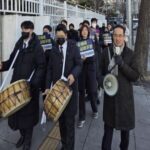
While people can go to the hospital when sick, trees don’t have that luxury. They often die from their ailments unless a tree doctor steps in. This profession has been gaining popularity recently.
According to JoongAng Ilbo, Seung Eon Lee, a tree doctor, used to work in the IT industry. He switched his career to becoming a tree doctor after wrestling with computers daily.
Tree doctors are nationally certified professionals who can diagnose and treat various problems in trees.
They perform surgeries on trees injured by traffic accidents or other external factors and walk through pine forests with syringes to prevent pine wilt disease.

The tree doctor system was introduced in June 2019 following the revision of the Forest Protection Act.
To obtain a tree doctor certification, one must meet one of the following conditions: hold a related master’s degree, get a professional engineer certificate, or have years of practical experience.
One can qualify to take the exam after completing 150 hours of education at a tree doctor training institution.
The final exam is challenging, as it evaluates knowledge levels and requires practical skills such as surgery. This makes the final pass rate relatively low.
Only those who pass the final exam can establish a tree hospital and provide tree treatment services.

After passing the exam, Mr. Lee started working as an intern at a tree hospital. He says an intern’s salary starts from $2,500. Recently, Mr. Lee has established his tree hospital. As of 2022, the annual revenue of three hospitals nationwide is around $312,000.
The Korea Forest Service explained that the tree doctor system also creates jobs by providing opportunities for the general public to become tree doctors.

Although not widely known to the public, the number of people preparing to become tree doctors is gradually increasing.
The Plant Hospital, a tree doctor training institution in Seoul at Seoul National University, says that while most of the students were in their 40s and 50s when the system was first introduced, these days, many people in their 20s and 30s are also enrolling.
A Korea Tree Protection Association representative explained, “The competition rate for the weekend classes, which working professionals can attend, has increased to 4-5:1. Many people get in after applying 2-3 times. The overall competition rate is about 3:1.”

Meanwhile, there is a regional disparity in the distribution of the three hospitals. In Gangwon Province, which has a high proportion of forests, there are 52 registered hospitals in 10 cities and counties, such as Chuncheon and Wonju. However, there are none in relatively small areas, such as Hoengseong and Pyeongchang.
Nationwide, 48% of all tree doctors are concentrated in the metropolitan areas of Seoul, Gyeonggi, and Incheon.
Both aspiring and active tree doctors are calling for full-scale national support.















Most Commented